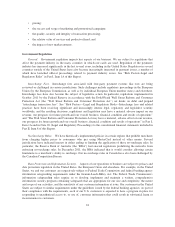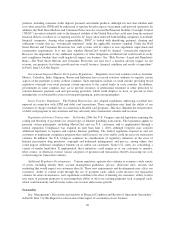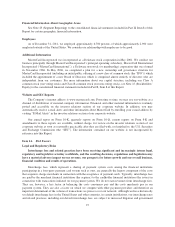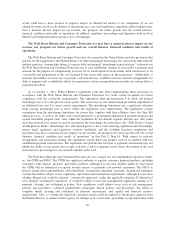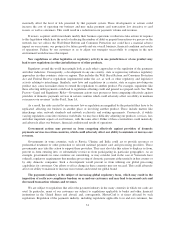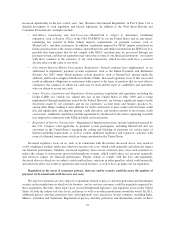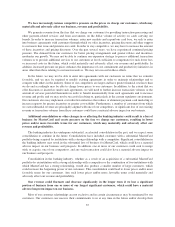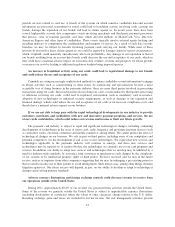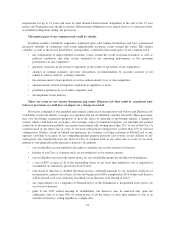MasterCard 2011 Annual Report Download - page 38
Download and view the complete annual report
Please find page 38 of the 2011 MasterCard annual report below. You can navigate through the pages in the report by either clicking on the pages listed below, or by using the keyword search tool below to find specific information within the annual report.charge, debit, prepaid, private-label and other types of general purpose and limited use cards, and electronic
transactions such as wire transfers and Automated Clearing House payments. Within the global general purpose
payment card industry, we face substantial and increasingly intense competition worldwide from systems such as
Visa, American Express, Discover, UnionPay and JCB, among others. Visa has greater volume than we do, and
has greater scale and market share, as well as strong brand recognition, which may provide significant
competitive advantages. Moreover, some of our traditional competitors, as well as alternative payment service
providers, may have substantially greater financial and other resources than we have, may offer a wider range of
programs and services than we offer or may use more effective advertising and marketing strategies to achieve
broader brand recognition or merchant acceptance than we have. Our ability to compete may also be affected by
the outcomes of litigation, regulatory proceedings and legislative activity.
Certain of our competitors, including American Express, Discover, private-label card networks and certain
alternative payments systems, operate end-to-end payment systems with direct connections to both merchants
and consumers, without involving intermediaries. These competitors seek to derive competitive advantages from
their business models. For example, operators of end-to-end payment systems tend to have greater control over
consumer and merchant customer service than operators of four party payment systems such as ours, in which we
must rely on our issuing and acquiring financial institution customers. In addition, these competitors have not
attracted the same level of legal or regulatory scrutiny of their pricing and business practices as have operators of
four-party payment systems such as ours. Certain competitors may also hold competitive advantages as a result
of their organizational structures. See “Business-Competition” in Part I, Item 1.
If we are not able to differentiate ourselves from our competitors, drive value for our customers and/or
effectively align our resources with our goals and objectives, we may not be able to compete effectively against
these threats. Our competitors may also more effectively introduce their own innovative programs and services
that adversely impact our growth. Our customers can also develop their own competitive services. As a result,
our revenue or profitability could decline. We also compete against new entrants that have developed alternative
payment systems, e-Commerce payment systems and payment systems for mobile devices. A number of these
new entrants rely principally on the Internet to support their services and may enjoy lower costs than we do,
which could put us at a competitive disadvantage.
We also expect that there may be other changes in the competitive landscape in the future, including:
• Parties that process our transactions in certain countries may try to eliminate our position as an
intermediary in the payment process. For example, merchants could process transactions directly with
issuers, or processors could process transactions directly between issuers and acquirers. Large scale
consolidation within processors could result in these processors developing bilateral agreements or in
some cases processing the entire transaction on their own network, thereby dis-intermediating
MasterCard.
• Rapid and significant technological changes could occur, resulting in new and innovative payment
programs that could place us at a competitive disadvantage and that could reduce the use of MasterCard-
branded cards.
• Competitors, customers, governments and other industry participants may develop products that
compete with or replace value-added services we currently provide to support our transaction processing
which could, if significant numbers of cardholders choose to use them, replace our own processing
services or could force us to change our pricing or practices for these services.
• Participants in the payments industry may merge, create joint ventures or form other business
combinations that may strengthen their existing business services or create new payment services that
compete with our services.
Our failure to compete effectively against any of the foregoing competitive threats could materially and
adversely affect our revenues, operating results, prospects for future growth and overall business.
34


